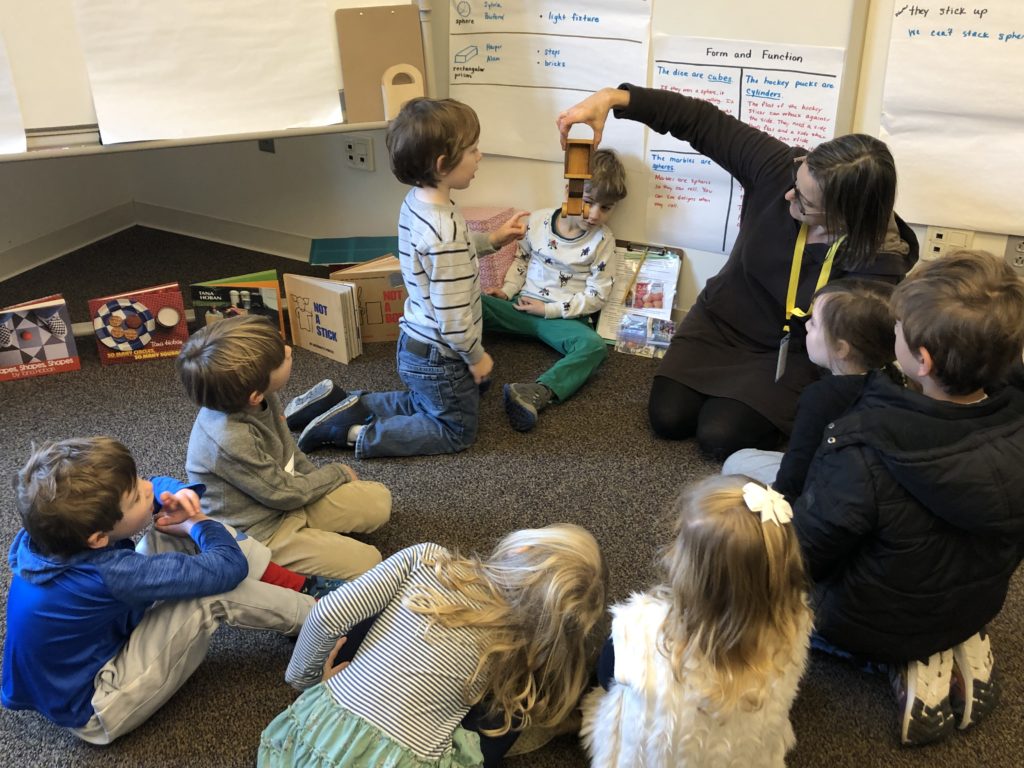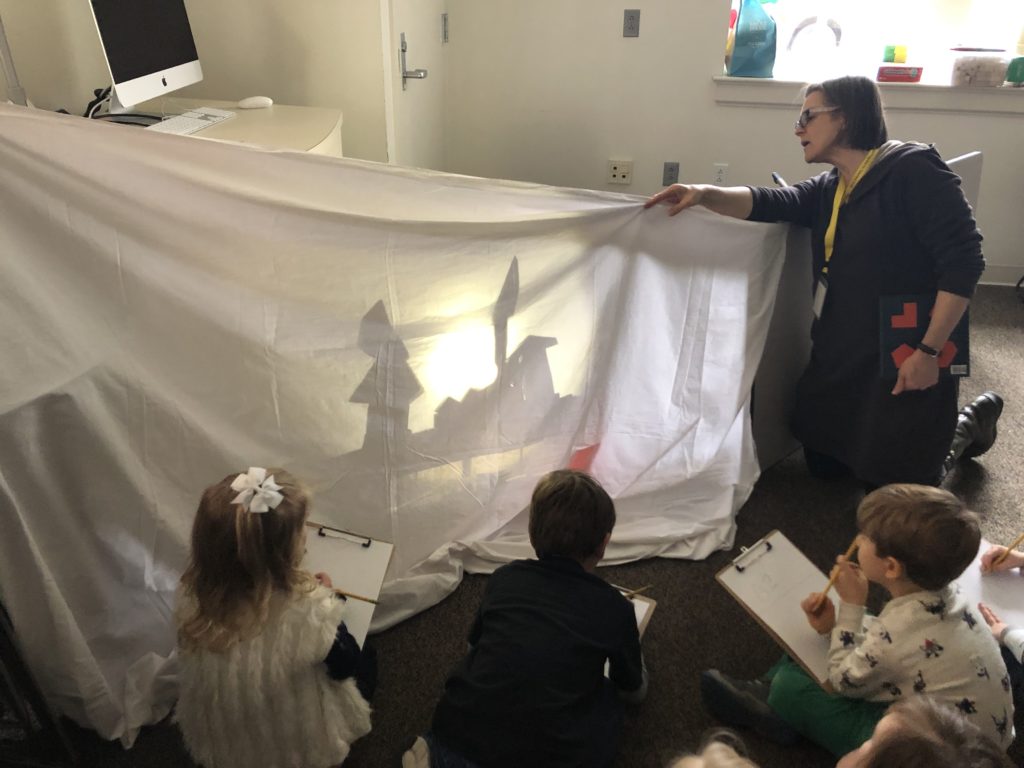We started our morning kicking a student’s homemade soccer ball around the lawn and comparing its performance to that of a manufactured soccer ball, then took our fun indoors for a morning meeting activity that challenged us to analyze a composite shape. Ask your expert: What three-dimensional shapes were combined to create the wooden toy truck? How many cylinders were used to form the wheels and axels? How many rectangular prisms did you see? Heading into this conversation with your child, know that we had a lively discussion about the number of rectangular prisms. All agreed that one rectangular prism formed the base of the truck, but thinking diverged thereafter. Some viewed the bed of the truck as one large rectangular prism, others said the truck bed couldn’t be a rectangular prism because it was “empty” rather than solid, and a few put forward the idea that the bed itself was constructed of five rectangular prisms (floor and four sides). Because all points of view were supported by mathematical argument, we did not push a “right” answer.
Today’s games and investigations supported our ability to communicate our ideas about shapes through words and drawings.
- Thank you to those who brought image clippings of three-dimensional shapes! We combined individual collections into a group Picture Sort, which gave us an opportunity to consider a wide range of everyday objects – including fruits, trash cans, balls, and oars – in relation to three-dimensional solids. Cylinders, spheres, and rectangular prisms were well-represented, and we identified many familiar shapes as components of composite shapes. If your geometer is inspired to continue this investigation at home, we’ll happily add any new images to our sort.
- What’s Missing? provided an engaging context for using mathematically precise vocabulary, with an emphasis on shape names and attributes. To play at home, collect a set of geometric shapes from around the house. create a simple 2×2 or 2×3 grid on blank piece of paper. Name each object while putting it in an empty space in the grid. Take turns covering or screening the grid and secretly removing one of the shapes; the role of the onlookers is to name the shape that’s missing. The person hiding the shape is allowed to give clues as needed by describing the missing shape’s attributes. After each round, reset or reorganize the board and play again!
- Mystery Shape challenged us to ask (and answer) questions about the attributes of a hidden shape. To play, use two identical sets of objects. Hide one set in an opaque container such as a bucket or paper bag, and leave the other on display. The shape selector reaches into the bag, chooses a shape (without peeking!), and takes questions from the shape guessers. Guessers must ask at least three yes/no questions about the shape’s attributes before attempting to name the shape. After each question, guessers set aside shapes that are eliminated, then form their next question based on the remaining shapes. Repeated play gives us experience in analyzing a collection of shapes and forming strong questions.
- Geometers’ further honed our ability to analyze shapes and justify our thinking in response to Christopher Danielson’s Which One Doesn’t Belong? As Danielson explains in the introduction to the book, any one of the four shapes depicted in each image can be “the one that doesn’t belong” – it all depends upon the perspective and analysis of the viewer. The book has inspired math enthusiasts to share their original puzzles via the Which One Doesn’t Belong website, where the game is extended beyond shape analysis to include number puzzles, graphs, and equations. Join our conversation by checking out the book from your local library or going online and solving some puzzles together.
- Partners created original cube puzzles for one another to solve. We kept two design constraints from last week (2×2 footprint; at least one face of each cube must align with the face of another cube) but changed the number of cubes from 6 to 7. Across the morning, our puzzle-makers generated 23 ideas and we determined that we’d created 18 unique designs!
- Using magnetic rods and steel spheres, geometers investigated the possibilities and limitations for modeling geometric shapes in a particular medium as they took up the question, “Which 3-D solids can be modeled with magnetix – and which cannot?” We discovered that some shapes simply aren’t possible. Ask your geometer which ones – and why.
In closing, work with our shadow curtain challenged us to analyze shapes we couldn’t fully see and share our thinking through words and drawings. Behind a curtain (made from a white sheet and affixed to nearby furniture with furniture-friendly tape), partners created a structure from our collection of 3-D shapes. When they were ready, they illuminated their construction with a flashlight, resulting in a projection of the construction’s shadow onto the curtain. On the “audience” side of the curtain, we did our best to analyze the structure’s component parts and draw the shapes from their shadows. During the “reveal,” the curtain was lifted so viewers could check our expectations and predictions against the actual construction. Which shapes were easiest to identify from their shadows? Which shapes surprised us? Do try this at home! All you need is at least two willing participants, a sheet, a flashlight, and some interesting objects – perhaps from last week’s pantry inventory.
Our optional geometers’ challenge for the week ahead is to imagine (and represent) a familiar space from a different perspective: Imagine you are a spider on the ceiling of your bedroom. You are looking down, with a bird’s eye view of your room. Draw what the spider would see. Spiders are invited to bring their drawings to share with our class next Saturday. Thank you for supporting our learning journey!
Christy Plummer
Great Photos from our Week


